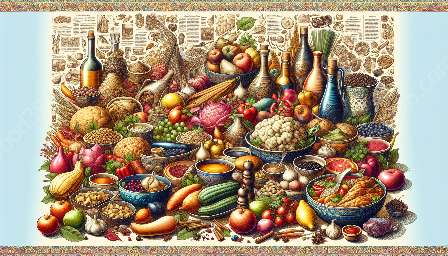Food has played a significant role in the rituals and traditions of ancient societies, including in burial rituals. This article explores the importance of food offerings in ancient burial rituals and their relationship to ancient food traditions and culture, as well as the origin and evolution of food culture in various ancient civilizations.
Ancient Food Traditions and Rituals
Ancient food traditions and rituals were deeply intertwined with religious and social practices. The act of sharing food was considered a sacred ritual in many ancient cultures, symbolizing communion, respect for the deceased, and honoring the gods.
In ancient Egypt, food offerings were an essential part of burial rituals. The deceased were often buried with food items, such as bread, beer, and meat, which were believed to sustain them in the afterlife. The Egyptians also placed food offerings in the tombs of their loved ones to ensure a plentiful and prosperous afterlife.
Ancient Greek and Roman cultures also incorporated food offerings into their burial rituals. It was believed that the deceased required sustenance in the afterlife, and therefore, food offerings, including grains, fruits, and beverages, were placed in tombs as a form of spiritual nourishment.
Significance of Food Offerings in Burial Rituals
The significance of food offerings in ancient burial rituals was multi-faceted. Firstly, food offerings were a way of nurturing and sustaining the deceased in the afterlife. Ancient societies believed that the deceased needed sustenance and nourishment in their journey to the afterlife, and food offerings served this purpose.
Secondly, food offerings were a symbol of respect and honor for the deceased. By providing food offerings, ancient civilizations expressed their reverence and care for the departed individuals, ensuring their well-being in the afterlife.
Furthermore, food offerings served as a means of celebrating the life and accomplishments of the deceased. In many ancient cultures, the types of food offered during burial rituals were carefully selected to reflect the individual's status, achievements, and contributions to society.
Lastly, food offerings in burial rituals were a way of establishing a connection between the living and the dead. Sharing food with the deceased was a way of maintaining a bond and a sense of continuity between the two realms, ensuring that the deceased remained a part of the community even in death.
Origin and Evolution of Food Culture
The origin and evolution of food culture can be traced back to the earliest human societies. Ancient hunter-gatherer communities developed rituals and traditions around food, often involving communal gatherings, feasting, and food offerings to deities and ancestral spirits.
As agricultural practices developed, food became deeply intertwined with religious beliefs and social customs. The cultivation of crops and the domestication of animals led to the abundance of food, which in turn gave rise to elaborate feasts, celebrations, and rituals centered around food.
Over time, different civilizations developed their unique food cultures, each with its distinct culinary traditions, rituals, and symbolic meanings associated with food. Food became not only a means of sustenance but also a form of cultural expression, reflecting the values, beliefs, and social structures of ancient societies.
As societies traded and interacted with one another, food culture evolved through the exchange of culinary techniques, ingredients, and traditions, leading to the fusion and diversification of food cultures around the world.
Conclusion
Food offerings in ancient burial rituals held profound significance, reflecting the cultural, religious, and social values of ancient civilizations. The act of providing food for the deceased symbolized sustenance, respect, and continuity, bridging the gap between the living and the dead. Additionally, the origin and evolution of food culture in ancient societies shaped the way food was perceived, shared, and celebrated, laying the foundation for the rich and diverse food traditions we know today.


